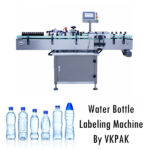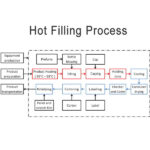Creative and unique beer beer can labels are just one way to gain attention and create a distinction from the large commercial breweries beers. The good news is that there are a variety of labeling technologies available that allow smaller breweries to exercise their artistic side and make a visual impact on beer lovers everywhere.
VKPAK provides almost all labeling solutions for beer cans, whether you are a start-up small business or even an individual, or a large-scale company; whether your beer can labels are self-adhesive pressure-sensitive labels or shrink labels such as PVC and PET, we can provide you with suitable labeling equipment.
Automatic Beer Can Sticker Labeling Machine


This machine belongs to a round bottle labeling machine which can be used for the full-cycle and half-cycle labeling of various circular bottles, and it has been widely applied to the round bottle products labeling of different sizes such as round jars, round bottle, round cans in cosmetics, food, medicine, daily chemical and other light industries.
Equipment composition:
Electrical cabinet, Conveying mechanism, Separate bottle device, Rolling label device, Brush label device, Labeling engine, Operation system and control system.
1. Powerful function: high-speed single-label labeling of round bottles can be realized;
2. Automatic bottle separation: the elastic pressure type bottle separation mechanism is used to effectively eliminate the bottle separation caused by the bottle error and improve the stability;
3. Touch screen control: The human-computer interaction interface has the function of operation and teaching, and the parameter modification is intuitive and clear;
4. Robust and hygienic: mainly made of stainless steel and high-grade aluminum alloy, with firm quality and meeting GMP production requirements;
5. Automatic shutdown function: production counting function, power saving function (when there is no production within the set time, the equipment will automatically switch to the power saving standby state), which is convenient for production management;
Beer Can Shrink Sleeve Labeling Machine


Sleeve labeling machine, also called sleeves labels applicator or sleeves labels inserting machine, which cut sleeves piece by piece and insert the sleeves to bottles, and then shrink the sleeves labels by steam shrinking tunnel or electrical heating tunnel to bottles tightly. The sleeves can label bottles’ body or seal bottles’ caps and necks.
This beer can sleeve labeling machine adopts international advanced technology to put ring marks on PET bottles (round and square) and fix them on the specific position of the bottle by thermal shrinkage.
The beer can sleeve labeling machine is compact and suitable for production line of different direction and height.
The mechanical part adopts modular combination design to make the machine more reasonable. The height adjustment adopts the motor lifting, the replacement material is simple. The unique knife disc design makes the cylinder film coil cut off more accurate and reliable.
Typical solutions we provided usually includes the following:
- Sleeve Applicator + Steam Shrink Tunnel + Drying Machine
- Sleeve Applicator + Electrical Shrink Tunnel
- Tamper Evident Bands Applicator + Electrical Hot Air Shrink Tunnel
According to the specific product and label position, of course, VKPAK will decide whether to use or not use optional accessory such like bottom-wrapping system, pre-heating system, valve system, moulds , mandrel etc. Whether your products are bottles, cans, jars, cups, made of plastic, glass or aluminum, empty or full, round, oval or irregular shape, you will get a perfect solution from us.
Working Principle:
When the bottle electric eye finds that the bottle comes over and thinks that it is necessary for continuous production, the bottle screw starts to operate the push bottle (the function of the bottle screw is to divide the bottles that are not equidistant from the initial speed of the new equidistant bottle). The bottle enters the core unit of the sleeve labeling system. When the labeling electric eye senses that there is a bottle, it immediately transmits the information to the control center PLC, and successively and continuously issues 4 instructions through the PLC: labeling, positioning and cutting.When the target is finished, the labeling process of one bottle is completed, and then the label finishing and shrinking unit is entered.
Main Features:
1. Full Face Stainless Steel hosts: the whole machine is not waterproof rust;
2. Adjustable cutter head: original cyclotron cut, double-sided blade, long life;
3. Single positioning center guide pillar: Tag channeled more stable;
4. Synchronized dividing device: bottle feeding is more stable;
5. Label brush under Group: sets of standard precision is more accurate;
6. Label control electric eye shelf: unique combination of tail and electric eye, improve membrane material cutting accuracy;
Why are Beer Cans Growing in Popularity?
Over the past decade, aluminum cans have gone from being almost non-existent in the craft brew market to making up about one-third of total packaged production. On average, 45% of packaged beer from these small companies comes in cans. For these small producers, using aluminum cans improves quality while cutting costs and simplifying logistics:
- Aluminum cans block all light and keep oxygen from interacting with the beer, keeping it fresh longer than bottles.
- A filled aluminum can weighs about 1/3 less than a filled bottle and it’s easier to stack – saving substantial money on transport. Cans are also easier to ship in small packages, making it practical to offer canned beer through mail order.
- Since they aren’t breakable, cans are allowed in places where glass bottles are banned, like beaches, music venues and sports parks.
- Aluminum is more eco-friendly than glass. Aluminum cans are easy to recycle and have a high recycled material content. (On average, an aluminum can is made of 86% recycled material.) Two out of every three cans is recycled, compared to one out of four glass bottles (and one out of 30 plastic bottles). Turnaround time for recycling can be as little as 6 weeks. Transporting and refrigeration-related emissions are also 35-49% lower than glass bottles.
- Consumer preferences are starting to shift. Cans used to be reserved for cheap, low-quality beer. However, as more craft beer companies have shifted to cans and worked to educate consumers on the container’s benefits, buyers are more accepting of canned craft brews.
- The packaging industry is catching up to the demands of the craft brew industry. Smaller, less costly labeling equipment is bringing down prices to be in line with bottling equipment. If you’re making the leap from hand-filled and labeled bottles, canning is now a viable, affordable option!
The importance of beer can labeling equipment
No matter how fast you can bottle and label your beer, your overall output will be limited by the speed at which you can package it and get it to market. In this process, one major challenge experienced by many craft brewers is the printing and application of labels.
Labeling equipment comes in a range of prices, which often seems overwhelming to craft brewers operating on a limited budget. However, the addition of efficient labeling equipment can increase productivity dramatically and pay for itself quickly by ramping up output immediately.
Efficiency
Typically most craft breweries and microbreweries start without a huge upfront capital investment, so to begin production, they have to hand label each beer bottle.
However, the addition of one table-top or semi-automatic labeling machine can increase productivity by almost 500%, allowing up to 150 bottles per hour to be labeled. These smaller labelers are more affordable for new or smaller breweries.
Fully-automatic in-line labeling machines are physically larger and a little more expensive, but they can label up to 500 bottles per hour. This efficiency increase allows breweries to fill more bottles without getting backed logged at the labeling stage.
As increasingly more beer leaves the warehouse and hits the market, the labeling equipment will more than justify the investment.
Quality
The use of automated labeling equipment gives a craft brewer the ability to create consistent, high-quality products for craft beer customers. A well-designed, accurately-placed, and highly-recognizable beer label is a crucial marketing tool.
Label machines are faster and offer accurate placement with fewer errors than the manual hand labeling process. The best labeling equipment includes stabilizers that ensure the label is placed evenly and in the same location over and over without movement vertically or horizontally.
Cost vs. Value
While the upfront cost of purchasing or leasing new labeling equipment may seem daunting, it’s essential to evaluate all of the cost factors that affect your brewery.
For instance, the one-time purchase of labeling equipment will be significantly less than the cost of hiring a full-time employee to apply labels to bottles. If you already have workers attaching labels, automating your labeling process will free them up to do more pressing or profitable tasks.
Another important part of the cost equation is the reduction of wasted and defective products coming off the line. Labeling equipment is consistent and reliable, so human error is eliminated and fewer labels are misplaced, which saves money. There is something to understanding efficiency and cost savings versus the actual cash price of the equipment. Ultimately, the value of the equipment overcomes the cost in many significant ways.
Evaluating the value of any labeling system means taking into account both the advantages and cost of the labeler you intend to use in your bottling line. These numbers are a byproduct of both the increased efficiency and overall improvement in quality that you will see once your production begins to grow.
How do we choose a beer can labeling machine?
Solid color labels can be applied with labeling equipment at a considerably low price point. However, colored labels are also noticeably separate from the can. These labels are mostly used by the smallest breweries (and even some homebrewers).
Clear labels conform to the can, making them indistinguishable from printed cans. Automatic labeling machines usually use light sensors to determine label and can orientation. To use clear labels, you’ll need to upgrade to capacitive sensors, increasing cost to the labeling machine. Keep in mind that “clear” does not have to mean translucent.
The craft brew market is dominated by three can sizes:
- 12 oz. standard drink can
- 16 oz “pounder” can
- 32 oz. growler can – a.k.a. the “crowler”
With the right beer can labeler, you can easily switch between can sizes, adding flexibility without increasing equipment costs. Speed will vary depending on the length of the labels being used. A standard label for a 12 oz. can is 8 inches long, while a crowler label is 9 inches in length. That means piece-per-minute will be about 12% slower when producing crowlers as opposed to 12 oz. cans. In practice, this shouldn’t be much of an issue since filling station times will see a larger increase than labeling times.
Our round bottle labeling machine is an ideal turn-key solution for low production runs of can labeling. It works with products of varying sizes, and the onboard computer can save several label configurations. Once you have a container calibrated, you can bring the settings back up when you’re ready to switch to producing it.
VKPAK promises to provide more than just a piece of equipment for your assembly line - we are your partner. Contact VKPAK, our engineers can set you up with beer can labeling equipment that fits your production line - big or small!











